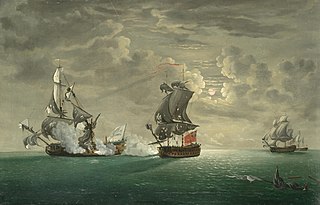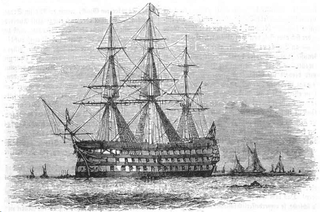
HMS La Hogue was a 74-gun third-rate ship of the line of the Royal Navy, launched on 3 October 1811 at Deptford. She was named after the 1692 Battle of La Hogue. "The La Hogue of 1811 [...] sported a green and chocolate lion, its grinning mouth displaying rows of white teeth and a huge red tongue."

HMS Neptune was a 98-gun second-rate ship of the line of the Royal Navy. She served on a number of stations during the French Revolutionary and Napoleonic Wars and was present at the Battle of Trafalgar in 1805.

HMS Monmouth was a 66-gun third-rate ship of the line of the Royal Navy, and was likely named for James, Duke of Monmouth. She served from 1667 to 1767, winning ten battle honours over a century of active service. She was rebuilt a total of three times during her career—each time effectively becoming a completely new ship.

HMS Ajax was a 74-gun third rate ship of the line of the Royal Navy, launched on 2 May 1809 at Blackwall Yard.

HMS Hannibal was a 74-gun third-rate ship of the line of the Royal Navy, launched on 15 April 1786, named after the Carthaginian general Hannibal. She is best known for having taken part in the Algeciras Campaign, and for having run aground during the First Battle of Algeciras on 5 July 1801, which resulted in her capture. She then served in the French Navy until she was broken up in 1824.

HMS Raisonnable was a 64-gun third-rate ship of the line of the Royal Navy, named after the ship of the same name captured from the French in 1758. She was built at Chatham Dockyard, launched on 10 December 1768 and commissioned on 17 November 1770 under the command of Captain Maurice Suckling, Horatio Nelson's uncle. Raisonnable was built to the same lines as HMS Ardent, and was one of the seven ships forming the Ardent class of 1761. Raisonnable was the first ship in which Nelson served.

HMS Royal William was a 120-gun first rate ship of the line of the Royal Navy, launched on 2 April 1833 at Pembroke Dock having taken eight years to build. She was one of the largest ships ever built by the Royal Navy at that time, with a crew of 900 men. However, she was built during the long period of peace in Great Britain and never saw any meaningful service.

HMS Eagle was a 74-gun third rate ship of the line of the Royal Navy, launched on 27 February 1804 at Northfleet.

HMS St Vincent was a 120-gun first-rate ship of the line of the Royal Navy, laid down in 1810 at Devonport Dockyard and launched on 11 March 1815.

HMS Princess Charlotte was a 104-gun first-rate ship of the line of the Royal Navy, built by Nicholas Diddams launched on 14 September 1825 at Portsmouth. The occasion was notable for the fact that the gates of the dry dock into which she was to be placed burst because of the high tide and more than 40 people were drowned.

HMS Trafalgar was ordered as a 98-gun second-rate ship of the line, re-rated as a 106-gun first-rate ship of the line whose keel was laid in 1813 and which was launched on 26 July 1820 at Chatham. She was designed by the Surveyors of the Navy, and was the only ship built to her draught.

HMS Vindictive was a 74-gun third-rate ship of the line of the Royal Navy, built by Nicholas Diddams at Portsmouth Dockyard and launched on 30 November 1813 at Portsmouth.

HMS Wellesley was a 74-gun third rate, named after the Duke of Wellington, and launched in 1815. She captured Karachi for the British, and participated in the First Opium War, which resulted in Britain gaining control of Hong Kong. Thereafter she served primarily as a training ship before gaining the almost surely unwanted distinction of being the last British ship of the line to be sunk by enemy action and the only one to have been sunk by an air-raid.

The Canopus-class ships of the line were a class of nine 84-gun two-deck second rates of the Royal Navy. Their design was based on an enlarged version of the lines of the captured French ship Franklin, since commissioned in the Royal Navy as HMS Canopus, although this ship herself was not included as a member of the class. The earlier ships were initially ordered as 80-gun third rates, but this classification was altered by changes in the rating system in February 1817. This class of ships is sometimes referred to as the Formidable class.

HMS Powerful was an 84-gun second rate ship of the line of the Royal Navy, launched on 19 May 1825 at Chatham Dockyard.

HMS Cumberland was a 70-gun third rate ship of the line of the Royal Navy, launched on 21 October 1842 at Chatham Dockyard. She carried a crew of 620 men.

HMS St Michael was a 90-gun second rate ship of the line of the Royal Navy, built by John Tippetts of Portsmouth Dockyard and launched in 1669.

HMS Burford was a 70-gun third rate ship of the line of the Royal Navy, built at Deptford Dockyard to the 1719 Establishment, and launched on 19 July 1722. Burford was notably the early posting of both John Forbes and John Byng, both of whom rose to become Admirals.

HMS Victory is a 104-gun first-rate ship of the line of the Royal Navy. She was ordered in 1758, laid down in 1759, and launched in 1765. With 245 years of service as of 2023, she is the world's oldest naval vessel still in commission.

The National Nautical School in Portishead, within the English county of Somerset, was created in 1869 for destitute and neglected boys of Bristol. It was based on HMS Formidable moored off the shore from 1870 until 1906. It then used a purpose built facility nearby until its closure in 1982.





















